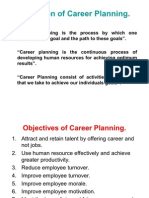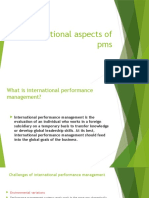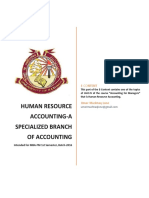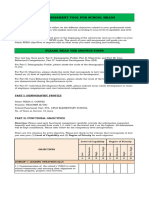Human Resource Audit
Human Resource Audit
Uploaded by
sanrocky007Copyright:
Available Formats
Human Resource Audit
Human Resource Audit
Uploaded by
sanrocky007Copyright
Available Formats
Share this document
Did you find this document useful?
Is this content inappropriate?
Copyright:
Available Formats
Human Resource Audit
Human Resource Audit
Uploaded by
sanrocky007Copyright:
Available Formats
Human Resource Audit
Introduction : An audit in general terms, means examination and verification of books of accounts and records. Personnel/HR Audit means a systematic and comprehensive analysis of all activities and results of a personnel programme. Definition of HR Audit : Personnel / HR Audit refers to as examination and practices to determine the effectiveness of personnel management. - (G. Seybold) Personnel / HR Audit is an investigative, analytical and comparative process. It not only listens but looks for and discovers answers. It undertakes a systematic search assuming that appropriate policies and programmes can produce positive results which can be identified and evaluated. - (Dale Yoder) Objectives of HR Audit : HR Audit is undertaken to achieve the following objectives : a. To measure the effectiveness of personnel programmes and activities by review all the management programmes, b. To determine what should or should not be done in future for attaining better employee performance,
c. d. e.
To evaluate the extent to which managerial policies have been implemented, To evaluate the performance of employees, To decide on the type of and manner in which managerial training and development programmes need to be carried out.
Importance of HR Audit : HR Audit has acquired the status of a tool through which managers can control the programmes and practices of the HR Dept. as well as evaluation of the results of such programmes on other employees. The following points reflect the increasing importance of HR Audit : a. The managerial philosophy has undergone tremendous change. There is a strong need being felt to encourage participation in organisational activities and to identify individuals with it. This can influence the organisational performance. Hence HR Audit is carried out. b. The Government has started intervening, more often than ever, in the manpower management. This is with the objective of protecting the interests of the employees, bringing an improvement in the working conditions and ensuring economic security to the workers. For this HR Audit is needed, c. The trade unions have become very strong. As a result of this, they often question the managerial competence of the organisation. In order to avoid industrial disputes, HR Audit is taken to evaluate managerial policies and performance,
d.
Rising wages, changing technical and professional skills and increasing expenditure on HR Dept. encourages the trend of conducting HR Audit.
Need for HR Audit : According to Dale Yoder, the need for HR Audit is felt due to the following reasons : a. Modern organisation are very large in size. As such they employ large number of employees and invest huge sums in other resources. To ensure effective resource utilisation, both men and materials, HR Audit is needed, b. The organisational structure includes many departments each engaged in a specific function. The efficient functioning of each department depends on continuous feedback. HR Audit ensures regular and reliable feedback, c. In certain cases, an organisation may have numbers of isolated plants. In order to implement and assess managerial policies on a uniform basis,HR Audit is undertaken, d. The greater the delegation of authority and decentralisatoin of power, greater is the need and value of a regular and formal audit process, e. In organisations where communication is not effective, need for HR Audit is felt.
Scope of HR Audit : The concept of HR Audit stress on the fact that management of HR is much more than just recruiting, hiring, retaining, and training employees. It examines the performance of policies and people in the organisation. The different areas covered by HR audit includes : a. Planning : This function involves programming, forecasting and scheduling the manpower requirements of an organisation. HR audit of this function involves identification of HR shortages, need for overtime, cost-benefit analysis and evaluation of plans for the development of present and future manpower. b. Staffing & Development : The function includes analyses of manpower requirements, sources of recruitment and selection, training programmes and transfer and promotion policies. HR audit of this function involves analyses of recruitment and training costs, labour turnover rate, career development / advancement guidance, implementation of non-discriminatory policies and providing promotional opportunities to the deserving employees. c. Organising : Organising involves maintaining structures for co-ordinating, communicating and making arrangement for all resource inputs. HR audit involves getting feedback, extent of formal organisation, job definitions and verifying reports and records. It encourages flexibility, reduce resistance to
d.
e.
f.
change and bringing about proper and effective communication. Commitment : This function calls for individual and group motivation, effort and contribution. HR audit involves evaluation of productivity and performance norms. It also demands job enlargement, wage and salary administration, sanctioning fringe benefits and conducting exit interviews. It also involves gaining high personal identification and ensuring employee satisfaction. Administration : This function is concerned with style of leadership schemes, grievance handling procedure, extent committees, strategies adopted to change expectations, increase involvement and encourage collective bargaining. Research & Innovation : This is an experimenting and theor-testing function in all areas of management.
HR Audits aims at identifying changes, studying reports and publication, preparing suggestion plans and testing old and new theories. Nature of HR Audit : HR audit involves evaluation of policies, procedures and practices. This analysis is based on time standards, cost records, test scores, training scores, interview records, grievance reports , work stoppages, medical reports, accident reports, turnover reports, payroll data and labour costs. It uses both quantitative and qualitative yardsticks for
evaluation. HR audit is generally conducted on an annual basis. The annual audit report includes statistical information on the activities performed, the results achieved, the costs involved and comparison of the results achieved, the costs involved and comparison of the objectives and accomplishment. This report gives useful information on the activities of the organisation. HR Audit may be internal or external. Internal audit is conducted by those employed in the organisation itself. External audit is conducted by professionals from outside the organisation. Audit Report : The report submitted by the HR Auditor is called audit report. The report should be submitted within a reasonable time. It should be based on the findings and be presented in a factual manner for ready reference in future. The use of graphics should be done wherever appropriate. But the report should not be longer than is necessary : An audit report should contain the following details : a table of the contents of audit a summary and conclusion of the audit a preface giving a brief account of the objectives of the audit a supporting data as is practical a summary that is more complete than that giving in the beginning of the report
an appendix which includes supporting data that would be too voluminous to be included in the body of the report. Signature of all the members involved in conducting the audit.
The contents of audit which include morale survey, safety report or any other item of general interest should be made available to the employees. The contents should be given to the top level of management only.
You might also like
- Boutique Build AustraliaDocument18 pagesBoutique Build AustraliaSamita Gautam100% (2)
- HR Policies in Usa UkaDocument11 pagesHR Policies in Usa UkaMohd NadeemNo ratings yet
- Airtel Recruitment and Selection PDFDocument11 pagesAirtel Recruitment and Selection PDFEr Bhatt Dhruvi0% (1)
- Project ReportDocument122 pagesProject ReportRammohanreddy Rajidi100% (1)
- Model of HRADocument5 pagesModel of HRAArghya D PunkNo ratings yet
- HRM Old Wine in New BottleDocument6 pagesHRM Old Wine in New BottlePARUL100% (1)
- Gome CaseDocument8 pagesGome CaseVaibhav KumarNo ratings yet
- Mu0013 - HR AuditDocument13 pagesMu0013 - HR AuditArunNo ratings yet
- Career PlanningDocument9 pagesCareer PlanningNova BansalNo ratings yet
- Method of Collecting Job DataDocument9 pagesMethod of Collecting Job DatamebinscorpionNo ratings yet
- Increased Concern of HRMDocument30 pagesIncreased Concern of HRMAishwarya Chachad33% (3)
- Introduction of HRM and Its OBJECTIVESDocument5 pagesIntroduction of HRM and Its OBJECTIVESMahnoor AslamNo ratings yet
- Selection Process in HRMDocument14 pagesSelection Process in HRMKaleem KhanNo ratings yet
- Bonus Act - 1965 - 1Document24 pagesBonus Act - 1965 - 1nawabrp100% (1)
- Human Resources Accounting and AuditDocument14 pagesHuman Resources Accounting and AuditsasaravanaNo ratings yet
- Presentation and Viva Voice QuestionsDocument4 pagesPresentation and Viva Voice QuestionsMehak Malik100% (2)
- Career Planning & Succession Planning: Prof. Preeti BhaskarDocument40 pagesCareer Planning & Succession Planning: Prof. Preeti BhaskarDrNeeraj N. RanaNo ratings yet
- Corporate Social Responsibility &Document13 pagesCorporate Social Responsibility &Sumedh DipakeNo ratings yet
- Calling Up AttendanceDocument2 pagesCalling Up AttendanceSwati SoniNo ratings yet
- SHRM-2marks NEWDocument15 pagesSHRM-2marks NEWjohnpratheesh100% (2)
- New Trends in Compensation mANAGMEENTDocument15 pagesNew Trends in Compensation mANAGMEENTshivaniNo ratings yet
- HRD Matrix: Submitted byDocument21 pagesHRD Matrix: Submitted bykusumNo ratings yet
- Scope of AuditDocument3 pagesScope of AuditA-wan SafwanNo ratings yet
- International PmsDocument23 pagesInternational PmsHooHaa RtvNo ratings yet
- Recommendations of The Goiporia CommitteeDocument7 pagesRecommendations of The Goiporia Committeeneeteesh_nautiyalNo ratings yet
- Computer Application in HRMDocument6 pagesComputer Application in HRMVijay KishanNo ratings yet
- EDDocument8 pagesEDNaganandaKu67% (3)
- Ethics in HRMDocument7 pagesEthics in HRMVinay RamaneNo ratings yet
- Project Report On "Types of Allowances and Their Permissible LimitsDocument34 pagesProject Report On "Types of Allowances and Their Permissible LimitsPooja Jain100% (1)
- Unit 3.2modes of Creating Charge FR LoanDocument8 pagesUnit 3.2modes of Creating Charge FR LoanVelankani100% (1)
- Bba G Iii Unit-I Ed-307 E-NotesDocument25 pagesBba G Iii Unit-I Ed-307 E-NotesDeepanshu baghanNo ratings yet
- Effectiveness of Training and Development in Banking and Other Sector With Special Reffernce To MumbaiDocument45 pagesEffectiveness of Training and Development in Banking and Other Sector With Special Reffernce To MumbaisnehaamhatreNo ratings yet
- .... Importance of Quality Circles - HDFCDocument87 pages.... Importance of Quality Circles - HDFCnawazNo ratings yet
- T&D Spiral Model-3Document14 pagesT&D Spiral Model-3Faqrul HassanNo ratings yet
- TYPES OF TRAINING MethodsDocument23 pagesTYPES OF TRAINING MethodsHaresh KNo ratings yet
- Accounting Standard 5Document11 pagesAccounting Standard 5Payal Malik100% (1)
- Fringe Benefits in HRMDocument6 pagesFringe Benefits in HRMMudit ChandanNo ratings yet
- income From Salary-Problems, Theory and Solutions: by Prof - Augustin AmaladasDocument76 pagesincome From Salary-Problems, Theory and Solutions: by Prof - Augustin AmaladasAnkit Dhyani100% (6)
- Mba Project Report On HDFC BankDocument17 pagesMba Project Report On HDFC BankSai YaminiNo ratings yet
- Financial Management 5th Sem. NotesDocument4 pagesFinancial Management 5th Sem. NotesAmit Mondal0% (1)
- Parallel Learning StructureDocument30 pagesParallel Learning StructurekunchadkaNo ratings yet
- HRH Group of Hotels - Training ReportDocument88 pagesHRH Group of Hotels - Training Reportankita_ahuja04100% (2)
- Sarath BabuDocument22 pagesSarath BabuChitra VaswaniNo ratings yet
- HRIS, HR Accounting, HR AuditDocument27 pagesHRIS, HR Accounting, HR AuditSoumya MyauNo ratings yet
- 2018 SHRM It - 1 QP KJDocument2 pages2018 SHRM It - 1 QP KJksk k100% (1)
- HR Project-3HD MediaDocument8 pagesHR Project-3HD MediaSanthoshi Priya0% (1)
- Human Resource Development in INDIADocument22 pagesHuman Resource Development in INDIAGangadharNo ratings yet
- HRM SlideDocument4 pagesHRM SlideTanjin PayelNo ratings yet
- NPA ManagementDocument18 pagesNPA ManagementVincy LuthraNo ratings yet
- Human Resource Utilization Is The Extent To WhichDocument12 pagesHuman Resource Utilization Is The Extent To WhichFaye Aseo100% (1)
- HRIS Survey On HDFC BankDocument24 pagesHRIS Survey On HDFC BankSudarshanAgarwal75% (4)
- Industrial Devlopment Bank of India (IDBI)Document13 pagesIndustrial Devlopment Bank of India (IDBI)nancyagarwalNo ratings yet
- Test & InterviewDocument15 pagesTest & InterviewSe SathyaNo ratings yet
- Cholamandalam Investment and Finance Company LimitedDocument11 pagesCholamandalam Investment and Finance Company LimitedFcok100% (1)
- UNIT-3 Industrial Relation and International Practices in Industrial RelationDocument14 pagesUNIT-3 Industrial Relation and International Practices in Industrial RelationAkshita akshitaNo ratings yet
- A Study On Awareness and Effective Utilization of Esi Benefits Among Employees in One of The Leading Hospitals in BangloreDocument4 pagesA Study On Awareness and Effective Utilization of Esi Benefits Among Employees in One of The Leading Hospitals in BangloreSayooj Ns100% (1)
- Research Report 2020Document67 pagesResearch Report 2020RUPAM SINGHNo ratings yet
- Ba7034 - Industrial Relations & Labour WelfareDocument20 pagesBa7034 - Industrial Relations & Labour WelfareRaja .S0% (1)
- Human Resource Accounting-A Specialized Branch of AccountingDocument11 pagesHuman Resource Accounting-A Specialized Branch of AccountingMIR FAISAL YOUSUFNo ratings yet
- Assignment HR Audit SKMDocument6 pagesAssignment HR Audit SKMAiman BegNo ratings yet
- HR Audit Methodology Dr. Deepak SharmaDocument8 pagesHR Audit Methodology Dr. Deepak SharmaRïtêsh ŊʌŋdïNo ratings yet
- Learning Activity 1-1 - INTRODUCTION TO COST ACCOUNTING, SCOPE, AND OBJECTIVES OF COST ACCOUNTINGDocument6 pagesLearning Activity 1-1 - INTRODUCTION TO COST ACCOUNTING, SCOPE, AND OBJECTIVES OF COST ACCOUNTINGRegina PhalangeNo ratings yet
- Inventory Management 1Document23 pagesInventory Management 1Sakib RahmanNo ratings yet
- Chapter 14 SCMDocument27 pagesChapter 14 SCMOARDE, JAKENo ratings yet
- ERP Operations: SAP Standard ReportsDocument10 pagesERP Operations: SAP Standard ReportsAnkur RastogiNo ratings yet
- CCM and STAR ProgramDocument40 pagesCCM and STAR ProgramjeNo ratings yet
- An Overview of Operations ManagementDocument2 pagesAn Overview of Operations ManagementPink WorkuNo ratings yet
- 3a. AUDIT ENGAGEMENT LETTER (FMI)Document3 pages3a. AUDIT ENGAGEMENT LETTER (FMI)Sumbul SammoNo ratings yet
- Holiday Homework-Xii-2024Document34 pagesHoliday Homework-Xii-2024Rudraa SinghNo ratings yet
- Evaluation of HRMDocument19 pagesEvaluation of HRMld_ganesh0% (1)
- B2B Vs B2C Product Strategy Differences and Similarities 1669718521Document14 pagesB2B Vs B2C Product Strategy Differences and Similarities 1669718521scribe360No ratings yet
- Untt-Y: Coanned With FamcrannarDocument12 pagesUntt-Y: Coanned With FamcrannarRoy mrunalNo ratings yet
- Bim Essential Guide Dfma PDFDocument72 pagesBim Essential Guide Dfma PDFninja100% (1)
- LS 3.90A - PSA 570. Going ConcernDocument4 pagesLS 3.90A - PSA 570. Going ConcernSkye LeeNo ratings yet
- Internal Audit Division: Audit of Business Continuity in The African Union-United Nations Hybrid Operation in DarfurDocument15 pagesInternal Audit Division: Audit of Business Continuity in The African Union-United Nations Hybrid Operation in DarfurGeorge SuarezNo ratings yet
- Supplier Quality General RequirementsDocument19 pagesSupplier Quality General RequirementsJaydip ParmarNo ratings yet
- Disaster and Emergency Management ProcedureDocument9 pagesDisaster and Emergency Management Proceduremanuel vasadreNo ratings yet
- Self Assessment Tools and Idp For School Heads Rizza CortezDocument7 pagesSelf Assessment Tools and Idp For School Heads Rizza CortezMaryGrace L. Boseo50% (2)
- Nature of ServiceDocument34 pagesNature of ServiceNurdin HidayahNo ratings yet
- HR Practices at Jaypee CementDocument6 pagesHR Practices at Jaypee Cementshiva2713100% (1)
- Difference Between Marketing and SellingDocument7 pagesDifference Between Marketing and SellingSAMAYAM KALYAN KUMARNo ratings yet
- BPF Template FileDocument34 pagesBPF Template FileSravani NadakuditiNo ratings yet
- PeopleDocument20 pagesPeoplekasun.ebNo ratings yet
- NLS Resume 2023Document2 pagesNLS Resume 2023Cliford EstradaNo ratings yet
- Industrial Marketing Management: Hyung-Su Kim, Young-Gul KimDocument13 pagesIndustrial Marketing Management: Hyung-Su Kim, Young-Gul KimGeorge BosireNo ratings yet
- Manufacturing QuestionsDocument29 pagesManufacturing QuestionsSreehari ReddyNo ratings yet
- Amanda Tremblay at Citrine SolutionsDocument10 pagesAmanda Tremblay at Citrine SolutionssanjaanNo ratings yet
- Characteristics of Market Oriented Organisations 1Document3 pagesCharacteristics of Market Oriented Organisations 1nikhil khajuriaNo ratings yet
- Walmart'S Human Resource ManagmentDocument9 pagesWalmart'S Human Resource ManagmentHai HelloNo ratings yet

























































































